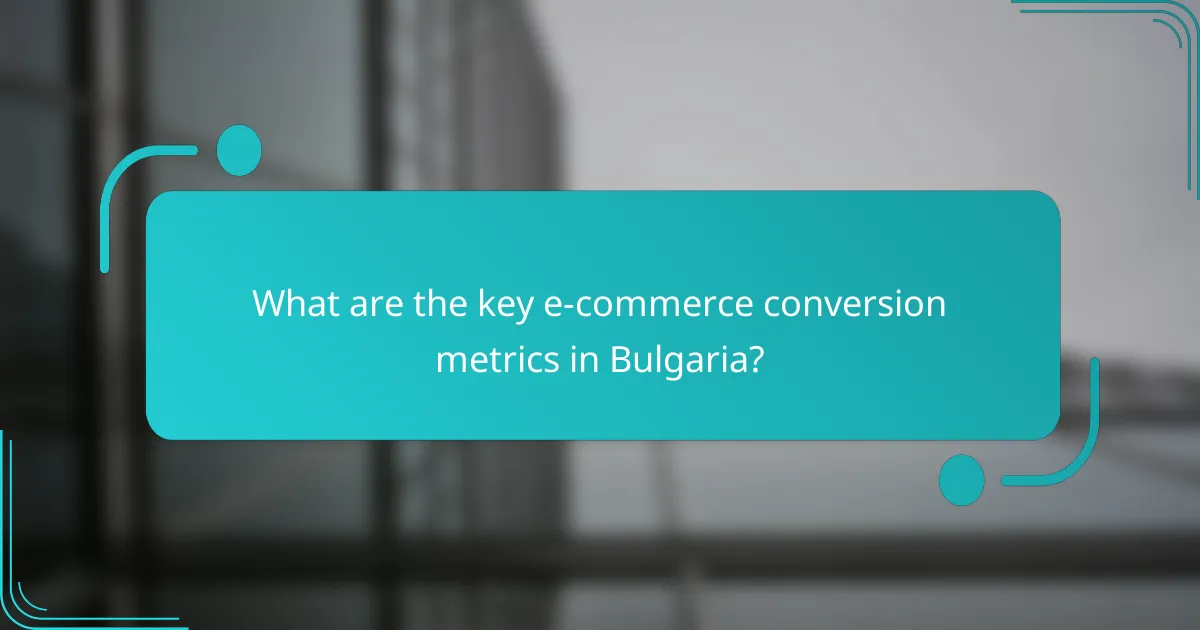In Bulgaria’s evolving e-commerce landscape, understanding key conversion metrics such as average conversion rate, cart abandonment rate, customer acquisition cost, and return on ad spend is essential for optimizing online sales. By enhancing user experience and employing targeted marketing strategies, businesses can significantly improve their conversion rates and overall profitability. Utilizing tools like Google Analytics and Hotjar allows for effective tracking and analysis of these vital metrics, enabling informed decision-making and strategic growth.

What are the key e-commerce conversion metrics in Bulgaria?
The key e-commerce conversion metrics in Bulgaria include average conversion rate, cart abandonment rate, customer acquisition cost, and return on ad spend. Understanding these metrics helps businesses optimize their online sales performance and improve profitability.
Average conversion rate
The average conversion rate in Bulgaria typically ranges from 1% to 3%, depending on the industry and the effectiveness of marketing strategies. A higher conversion rate indicates that a larger percentage of visitors are completing purchases, which is crucial for e-commerce success.
To improve this metric, businesses should focus on enhancing website usability, optimizing product pages, and providing clear calls to action. Regularly testing different elements, such as layouts and content, can lead to better conversion outcomes.
Cart abandonment rate
The cart abandonment rate in Bulgaria can be significant, often hovering around 60% to 80%. This means that a large number of shoppers add items to their carts but do not complete the purchase.
To reduce cart abandonment, businesses should simplify the checkout process, offer multiple payment options, and ensure transparency regarding shipping costs. Sending follow-up emails to remind customers about their abandoned carts can also help recover lost sales.
Customer acquisition cost
Customer acquisition cost (CAC) in Bulgaria varies widely but generally falls between BGN 50 to BGN 200 per customer. This metric reflects the total cost of acquiring a new customer, including marketing and advertising expenses.
To manage CAC effectively, businesses should analyze the performance of different marketing channels and focus on those that yield the best return. Implementing referral programs and leveraging social media can also help lower acquisition costs.
Return on ad spend
Return on ad spend (ROAS) in Bulgaria is typically expected to be at least 4:1, meaning that for every BGN spent on advertising, businesses should aim to generate BGN 4 in revenue. This metric is crucial for assessing the effectiveness of advertising campaigns.
To maximize ROAS, businesses should continuously monitor ad performance and adjust targeting strategies based on customer behavior. A/B testing different ad creatives and optimizing for high-converting keywords can lead to improved returns on advertising investments.

How can Bulgarian e-commerce businesses improve conversion rates?
Bulgarian e-commerce businesses can enhance conversion rates by focusing on user experience, product presentation, and targeted marketing strategies. Implementing effective website design, improving product descriptions, and utilizing personalized marketing can significantly influence customer decisions and boost sales.
Optimizing website design
Website design plays a crucial role in conversion rates. A clean, user-friendly layout that is mobile-responsive can help keep visitors engaged. Ensure that navigation is intuitive, with clear calls-to-action that guide users toward making a purchase.
Consider using high-quality images and fast-loading pages, as these factors can reduce bounce rates. Aim for page load times under three seconds to maintain user interest. Regularly test different design elements to see what resonates best with your audience.
Enhancing product descriptions
Effective product descriptions can significantly impact conversion rates by providing potential customers with the information they need to make informed decisions. Use clear, concise language that highlights key features and benefits, and incorporate relevant keywords to improve search visibility.
Include customer reviews and ratings to build trust and credibility. Visual aids, such as videos or infographics, can also enhance understanding and appeal. Aim for descriptions that are engaging yet straightforward, typically around 100 to 200 words.
Implementing personalized marketing
Personalized marketing can greatly increase conversion rates by tailoring the shopping experience to individual preferences. Utilize data analytics to understand customer behavior and segment your audience based on their interests and past purchases.
Consider implementing targeted email campaigns that offer personalized recommendations or discounts. Retargeting ads can also remind potential customers of items they viewed, encouraging them to return and complete their purchase. Ensure that your marketing messages are relevant and timely to maximize engagement.
![]()
What tools are available for tracking e-commerce metrics in Bulgaria?
Several tools are available for tracking e-commerce metrics in Bulgaria, each offering unique features to help businesses analyze their performance. Google Analytics, Hotjar, and Shopify analytics are among the most popular options, providing insights into user behavior, sales performance, and website traffic.
Google Analytics
Google Analytics is a powerful tool for tracking e-commerce metrics, allowing businesses to monitor website traffic, user engagement, and conversion rates. It provides detailed reports on user demographics, behavior flow, and sales performance, which can be crucial for optimizing marketing strategies.
To effectively use Google Analytics, set up e-commerce tracking by enabling the e-commerce settings in your account. This will allow you to view metrics such as transaction data, average order value, and revenue generated. Regularly reviewing these metrics can help identify trends and areas for improvement.
Hotjar
Hotjar complements traditional analytics tools by offering heatmaps and session recordings, which visualize user interactions on your site. This can help you understand how visitors navigate your e-commerce platform and where they may encounter obstacles during the purchasing process.
To get started with Hotjar, implement its tracking code on your website. Use heatmaps to identify popular areas of your site and session recordings to observe user behavior. This qualitative data can provide insights that quantitative metrics alone may not reveal.
Shopify analytics
If you run your e-commerce store on Shopify, its built-in analytics tool provides essential metrics tailored for online businesses. Shopify analytics offers insights into sales trends, customer behavior, and product performance, making it easier to track your store’s success.
Utilize Shopify’s dashboard to monitor key performance indicators like total sales, conversion rates, and customer acquisition costs. Regularly analyzing these metrics can help you make informed decisions about inventory, marketing campaigns, and overall business strategy.

What are the common challenges faced by Bulgarian e-commerce sites?
Bulgarian e-commerce sites encounter several challenges that can hinder their conversion rates. Key issues include high competition, logistical difficulties, and payment processing hurdles that require strategic solutions to overcome.
High competition
The Bulgarian e-commerce market is characterized by a growing number of players, leading to intense competition. Businesses must differentiate themselves through unique value propositions, effective marketing strategies, and superior customer service to capture consumer attention.
To navigate this competitive landscape, e-commerce sites should focus on niche markets or specialized products that cater to specific consumer needs. Regularly analyzing competitors’ offerings and pricing can also provide insights for positioning.
Logistical issues
Logistical challenges, including shipping delays and inventory management, significantly impact Bulgarian e-commerce operations. Many consumers expect fast delivery, and any shortcomings in logistics can lead to abandoned carts and lost sales.
To mitigate these issues, businesses should partner with reliable logistics providers and consider implementing real-time tracking systems. Offering multiple shipping options can also enhance customer satisfaction and reduce cart abandonment rates.
Payment processing difficulties
Payment processing can be a significant hurdle for Bulgarian e-commerce sites, with issues such as limited payment options and concerns over security. Consumers may hesitate to complete purchases if they do not see familiar or trusted payment methods.
To improve conversion rates, e-commerce platforms should offer a variety of payment options, including credit cards, bank transfers, and popular local solutions like ePay or PayU. Ensuring compliance with security standards, such as PCI DSS, can also help build consumer trust and encourage transactions.

What role does mobile optimization play in Bulgarian e-commerce?
Mobile optimization is crucial for Bulgarian e-commerce as it directly influences user experience and purchasing decisions. With a significant portion of online shopping occurring on mobile devices, businesses must ensure their websites are responsive and user-friendly to capture this audience effectively.
Increased mobile traffic
In Bulgaria, mobile traffic has been steadily rising, with many consumers preferring to shop on their smartphones. This trend necessitates that e-commerce platforms prioritize mobile-friendly designs to accommodate users who browse and shop on the go. Companies that neglect mobile optimization risk losing potential customers to competitors with better mobile experiences.
To capitalize on increased mobile traffic, businesses should implement responsive web design, ensuring that their sites adapt seamlessly to various screen sizes. This approach not only enhances usability but also improves search engine rankings, as Google favors mobile-optimized sites.
Impact on conversion rates
Mobile optimization significantly impacts conversion rates in Bulgarian e-commerce. Research indicates that well-optimized mobile sites can see conversion rates increase by substantial margins, often in the range of 20-30%. This improvement is largely due to faster load times and simplified navigation, which enhance the overall shopping experience.
To boost conversion rates, businesses should focus on minimizing load times, ideally keeping them under three seconds. Additionally, simplifying the checkout process for mobile users can reduce cart abandonment rates, leading to higher sales. Implementing features like one-click purchasing and mobile wallets can further streamline transactions and encourage conversions.

How do seasonal trends affect e-commerce conversions in Bulgaria?
Seasonal trends significantly influence e-commerce conversions in Bulgaria, with notable fluctuations during specific times of the year. Understanding these trends helps businesses optimize their strategies to enhance sales during peak periods.
Holiday shopping spikes
In Bulgaria, holiday seasons, particularly around Christmas and New Year, see dramatic spikes in e-commerce conversions. Retailers often experience increases in traffic and sales, making it crucial to prepare marketing campaigns well in advance.
During these peak times, offering promotions, discounts, and special deals can attract more customers. Businesses should consider implementing targeted advertising and optimizing their websites for mobile users, as many shoppers browse and purchase via smartphones.
Impact of local events
Local events, such as festivals or national holidays, can also impact e-commerce conversions in Bulgaria. For instance, events like the Sofia International Film Festival or the Thracian Wine Festival can drive interest in related products, leading to increased online sales.
Merchants should align their marketing efforts with these events, offering relevant products or promotions that resonate with the local audience. Monitoring local calendars and planning campaigns around these dates can help maximize conversion rates during these unique opportunities.
